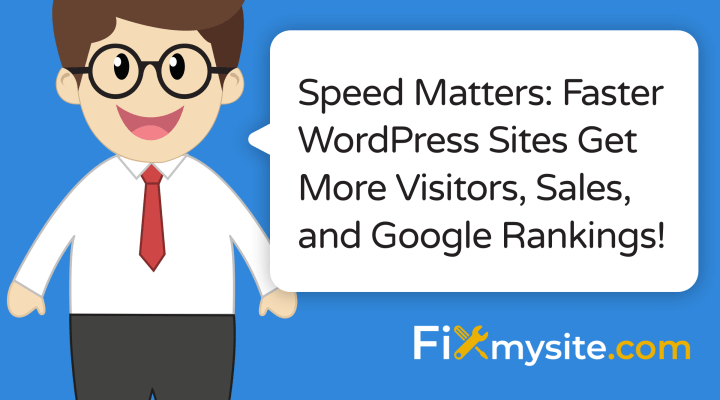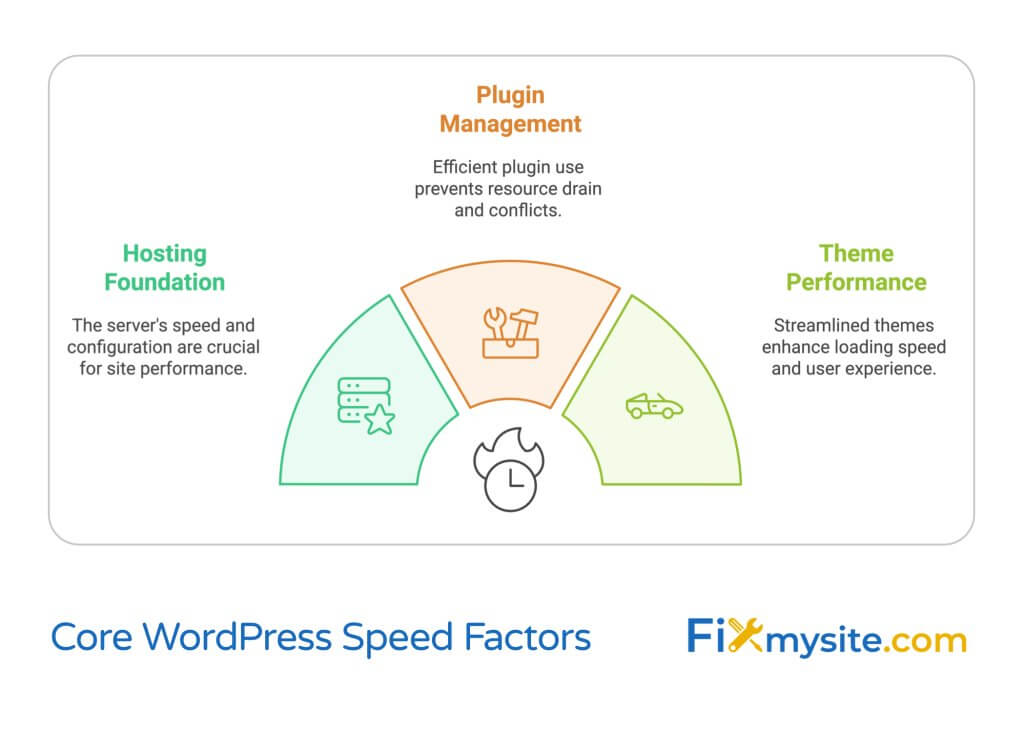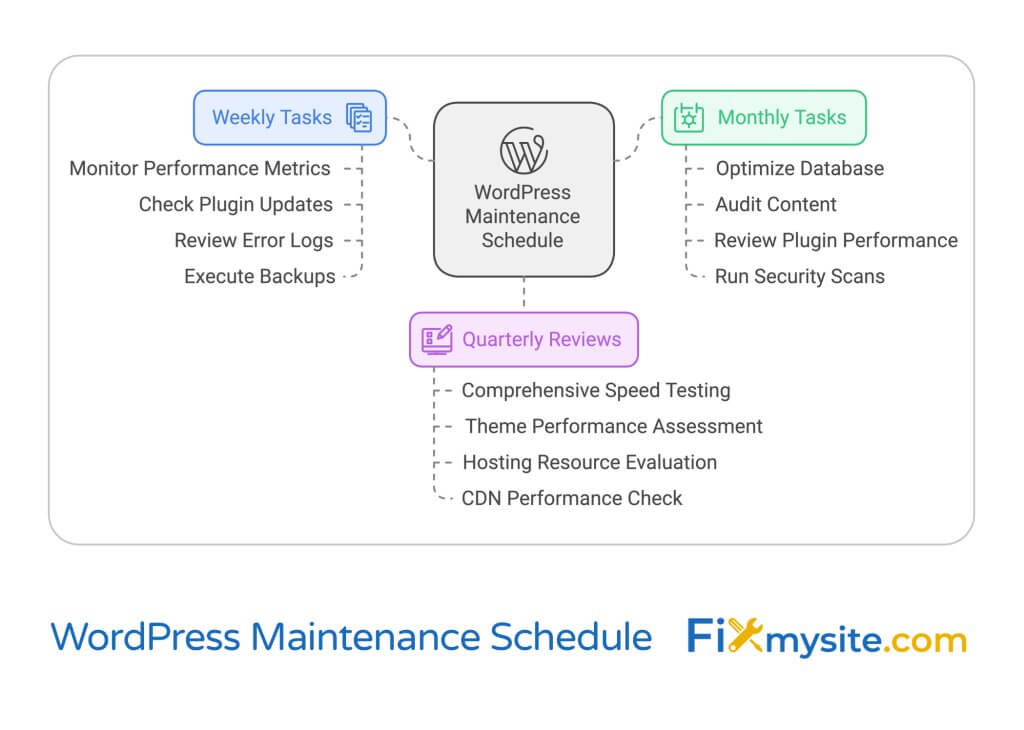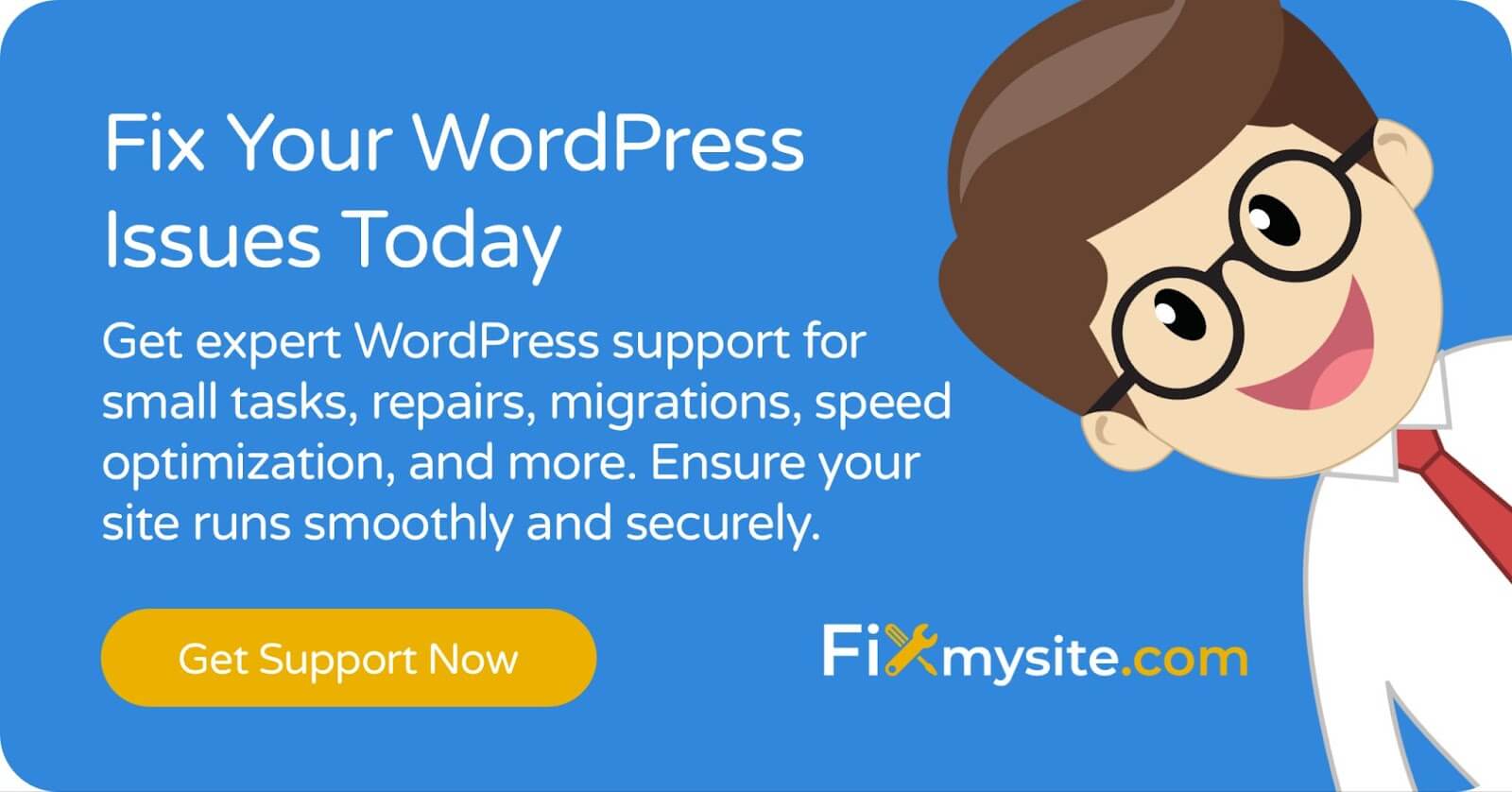
Picture this: Your WordPress site is costing you customers right now, and you don’t even know it.
Here’s a sobering fact: 53% of mobile site visitors will leave if a page takes longer than 3 seconds to load (Source: PurplePlanet).
That’s more than half your potential customers walking away before they even see what you offer!
As WordPress optimization specialists, we’ve seen countless businesses struggle with slow-loading sites. The good news? Most WordPress speed issues are completely fixable. Even better, improving your site speed can lead to significant business gains. According to research, improving site speed from 1 second to 0.3 seconds can increase conversion rates by 8.4% for retail sites (Source: Flow).
In this comprehensive guide, we’ll walk you through:
- Why your WordPress site might be running slow
- How to properly diagnose speed issues
- Step-by-step solutions to fix performance problems
- Prevention strategies to keep your site running smoothly
Whether you’re running a small business website, an e-commerce store, or a busy blog, you’ll find actionable tips to boost your site’s performance. Let’s dive in and get your WordPress site running at peak speed! 🚀
Understanding WordPress Speed: The Basics

What Makes a WordPress Site Slow?
Before diving into solutions, let’s understand what we’re dealing with. A WordPress site is like a complex machine with multiple moving parts, and each component can impact your site’s performance. Here are the primary factors that affect your site’s speed:
- Hosting Quality: Your hosting provider is like your site’s foundation. Budget hosting often means sharing limited resources with hundreds of other websites, leading to slower performance. Check out our guide on fixing slow WordPress sites for hosting-specific solutions.
- Plugin Overload: While plugins add functionality, they can also add weight to your site. Each plugin needs to load its own code, make database queries, and potentially load external resources. Some sites experience load times of over 30 seconds due to problematic plugins (Source: WordPress).
- Theme Complexity: Heavy themes with excessive code and complex design elements can significantly impact load times. The average WordPress page makes approximately 70 HTTP requests for mobile and 76 for desktop sites (Source: WP Rocket).
Impact on Your Business
| Speed Issue | Business Impact |
| 3+ Second Load Time | 53% of mobile visitors abandon your site |
| Speed Improvement | 8.4% increase in conversion rates for retail sites |
The technical aspects of WordPress speed directly translate to real business outcomes. When your site loads slowly:
- Visitors leave before seeing your content
- Search engines may rank you lower
- Conversion rates drop significantly
- User experience suffers
Need help optimizing your WooCommerce store specifically? Check out our detailed guide on fixing slow WooCommerce websites.
Technical Foundations
Understanding these basic technical elements will help you make better decisions about your site’s optimization:
- Server Response Time: How quickly your hosting server responds to requests
- TTFB (Time To First Byte): The time it takes for your browser to receive the first byte of data from your server
- Page Size: The total weight of all elements on your page, including images, scripts, and other resources
For those interested in technical optimization, we’ve covered advanced caching solutions in our guide about WordPress cache plugins.

Common Causes of WordPress Slowdown
Let’s dive deep into the specific issues that might be causing your WordPress site to underperform. Understanding these common culprits is the first step toward effective optimization.
Hosting-Related Issues
Your hosting environment is often the make-or-break factor in your site’s performance. Here are the key hosting-related problems we frequently encounter:
- Shared Hosting Limitations:
- Limited CPU resources
- Restricted RAM allocation
- Shared server space with potentially hundreds of other sites
- Server Location: Physical distance between your server and visitors can significantly impact load times
- Poor Server Configuration: Outdated PHP versions or unoptimized server settings can slow down your site
🚨 Warning: If you’re experiencing consistent slowdowns during peak traffic hours, it’s likely a hosting resource issue.
Plugin Problems
While plugins extend your site’s functionality, they can also be a significant source of performance issues. Here’s what to watch for:
- Plugin Overload: Some sites experience load times of over 30 seconds due to problematic plugins (Source: WordPress)
- Resource-Heavy Plugins:
- Statistics plugins that track every visitor action
- Page builders with complex layouts
- Social media integration plugins
- Live chat solutions
- Plugin Conflicts: Multiple plugins trying to perform similar functions can create conflicts and slow down your site
For optimal plugin performance, check out our guide on choosing the right caching plugins.
Theme Issues
Your WordPress theme can significantly impact your site’s performance. Common theme-related problems include:
- Bloated Code: Themes with unnecessary features and poor coding practices
- Heavy Framework: Some themes use resource-intensive frameworks that slow down page loading
- Unoptimized Media: Themes that don’t properly handle image scaling and optimization
Technical Configuration Problems
Technical issues often lurk beneath the surface. Here are the most common configuration problems:
| Configuration Issue | Impact on Performance |
| Outdated PHP Version | Slower processing, security vulnerabilities |
| No Caching Implementation | Repeated processing of static content |
| Unoptimized Database | Slower queries, increased server load |
Need help with technical configurations? Our guide on configuring WP Rocket with KeyCDN can help optimize your site’s performance.
💡 Pro Tip: Regular maintenance and updates are crucial for preventing these issues. Consider implementing a maintenance schedule or using our Speed Optimization Service to keep your site running smoothly.

How to Diagnose WordPress Speed Issues
Before you can fix your slow WordPress site, you need to accurately diagnose the problems. Let’s walk through a systematic approach to identifying speed issues.
Speed Testing Tools and Methodology
Start by running your site through multiple speed testing tools to get a comprehensive view of your performance:
| Testing Tool | What It Measures | Why It’s Important |
| Google PageSpeed Insights | Mobile and desktop performance | Direct Google insights and recommendations |
| GTmetrix | Detailed performance metrics | Comprehensive performance analysis |
| Pingdom | Real-user monitoring | Location-based performance data |
Key Performance Metrics to Monitor
Focus on these critical metrics when analyzing your site’s performance:
- Time to First Byte (TTFB): Should be under 600ms
- First Contentful Paint (FCP): Aim for under 2 seconds
- Largest Contentful Paint (LCP): Should be under 2.5 seconds
- Total Page Load Time: Keep under 3 seconds to prevent losing mobile visitors (Source: PurplePlanet)
Common Warning Signs
🚨 Watch out for these red flags:
- Slow admin dashboard loading
- Delayed response when saving posts
- Media library loading issues
- Sluggish page editor performance
Step-by-Step Diagnostic Process
- Baseline Testing
- Test your homepage speed
- Check multiple internal pages
- Test from different geographic locations
- Server Response Analysis
- Check TTFB using various tools
- Monitor server resource usage
- Review hosting performance metrics
- Resource Loading Analysis
- Examine waterfall charts
- Identify slow-loading resources
- Check for render-blocking resources
For e-commerce sites, check out our specialized guide on diagnosing WooCommerce performance issues.
Database Performance Check
Database issues can significantly impact site speed. Look for these indicators:
- High number of database queries per page
- Slow query execution times
- Large database size
- High number of post revisions
💡 Pro Tip: Use a staging site for testing to avoid impacting your live site. Learn more about proper testing environments in our WordPress maintenance checklist.
Mobile Performance Analysis
With mobile traffic dominating today’s web, pay special attention to mobile performance metrics. Check out our guide on fixing mobile usability issues for detailed insights.
Solutions to Speed Up Your WordPress Site
Now that we’ve identified the issues, let’s tackle the solutions. We’ll break this down into immediate fixes, technical optimizations, and long-term solutions to ensure sustainable performance improvements.
Immediate Fixes (Quick Wins)
💡 Quick Impact: These solutions can be implemented within hours and often show immediate results.
1. Image Optimization
- Compress existing images: Use tools like ShortPixel or Imagify
- Implement lazy loading: Only load images as users scroll
- Set proper image dimensions: Avoid browser scaling
2. Plugin Audit
- Deactivate and remove unused plugins
- Replace resource-heavy plugins with lighter alternatives
- Consolidate plugins with overlapping functions
Check our guide on choosing the right cache plugins for optimal performance.
Technical Optimizations
⚠️ Caution: Create a backup before implementing technical changes. Need help? Check our WordPress maintenance checklist.
1. Caching Implementation
- Page Caching: Implement a reliable caching solution
- Browser Caching: Set appropriate cache headers
- Object Caching: Implement Redis or Memcached for dynamic sites
2. Database Optimization
- Clean up post revisions
- Remove spam comments
- Optimize database tables
- Clear transients
3. Code Optimization
- Minify CSS, JavaScript, and HTML
- Combine files where appropriate
- Defer non-critical JavaScript
- Optimize CSS delivery
Long-term Solutions
| Solution | Impact | Implementation Difficulty |
| CDN Implementation | High | Medium |
| Hosting Upgrade | Very High | Low |
| Theme Optimization | High | High |
1. Content Delivery Network (CDN)
Implement a CDN to distribute your content globally. We’ve covered this in detail in our guide about configuring WP Rocket with KeyCDN.
2. Hosting Considerations
- Upgrade to managed WordPress hosting
- Choose servers closer to your target audience
- Ensure adequate server resources
3. Regular Maintenance
- Schedule regular performance audits
- Monitor resource usage
- Keep all components updated
Implementation Priority Checklist
- ✅ Optimize images and implement lazy loading
- ✅ Set up caching
- ✅ Clean up plugins and database
- ✅ Implement CDN
- ✅ Consider hosting upgrade
For e-commerce sites, don’t forget to check our specialized guide on optimizing WooCommerce performance.
Prevention: Keeping Your Site Fast
Optimizing your WordPress site isn’t a one-time task—it’s an ongoing process. Let’s explore how to maintain peak performance and prevent future slowdowns.
Regular Maintenance Tasks
Weekly Tasks:
- Monitor performance metrics
- Check for plugin updates
- Review error logs
- Backup your site
Monthly Tasks:
- Database optimization
- Content audit
- Plugin performance review
- Security scan
Quarterly Tasks:
- Comprehensive speed testing
- Theme performance review
- Hosting resource assessment
- CDN performance check
Best Practices for Ongoing Performance
| Area | Best Practice | Why It Matters |
| Content Management | Optimize media before uploading | Prevents accumulation of large files |
| Plugin Management | Regular plugin audits | Maintains lean site architecture |
| Database Management | Regular cleanup and optimization | Ensures efficient data retrieval |
Monitoring and Alert Systems
Set up monitoring systems to catch issues before they impact users:
- Implement uptime monitoring
- Set up performance alerts
- Monitor resource usage
- Track user experience metrics
💡 Pro Tip: Consider our WordPress Care Plan for automated monitoring and maintenance.
Conclusion
A slow WordPress site isn’t just frustrating—it’s costly. Remember that 53% of mobile visitors will abandon a site that takes more than 3 seconds to load (Source: PurplePlanet). By implementing the solutions we’ve covered and maintaining good practices, you can ensure your site stays fast and efficient.
Key Takeaways:
- Regular maintenance is crucial for sustained performance
- Monitor your site’s speed consistently
- Keep plugins and themes updated
- Optimize new content before publishing
- Consider professional help for complex issues
Need Help Speeding Up Your WordPress Site?
Our team of WordPress experts can help optimize your site’s performance and implement all the solutions discussed in this guide. Check out our Speed Optimization Service or contact us for a custom solution.


